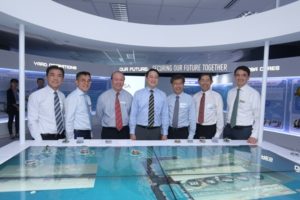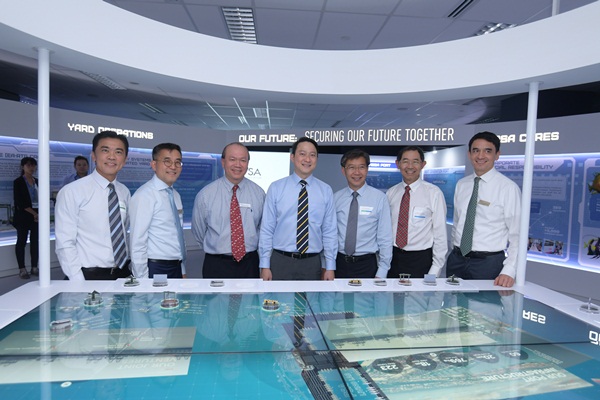 Singapore has unveiled its maritime industry roadmap with the aim to grow the sector’s value-add by SGD4.5 billion (US$3.4 billion) and create over 5,000 jobs by 2025.
Singapore has unveiled its maritime industry roadmap with the aim to grow the sector’s value-add by SGD4.5 billion (US$3.4 billion) and create over 5,000 jobs by 2025.
The Sea Transport Industry Transformation Map (ITM)—which will drive Singapore’s vision to be a global maritime hub for connectivity, innovation, and talent—was launched January 12 by Dr. Lam Pin Min, senior minister of state for Ministry of Transport and Ministry of Health.
Developed by the Maritime and Port Authority of Singapore (MPA) in partnership with the industry, unions, and other government agencies, the Sea Transport ITM builds on MPA’s strategic long-term plans to develop Singapore’s next-generation port and strengthen the city-state’s international maritime center (IMC).
Specific initiatives have been laid out under the Sea Transport ITM to catalyze innovation, drive productivity improvements, as well as enhance the skills of the maritime workforce.
“The aim is to grow the sector’s value-add by S$4.5 billion and create more than 5,000 good jobs by 2025,” said MPA.
MOU signing
At the ITM launch, five memorandums of understanding (MOUs) were signed between MPA and various tripartite partners to underscore the collective commitment of stakeholders to drive innovation, productivity, and human capital development in transforming Maritime Singapore.
The maritime industry contributes 7% of Singapore’s gross domestic product (GDP) and employs over 170,000 people. In 2017, Singapore’s container throughput grew by 9% to 33.7 million TEUs, from 30.9 million TEUs in 2016.
Under the master plan, Singapore will continue to strengthen its IMC to enhance its long-term competitiveness and value proposition to shipping companies and maritime service providers.
“We will also continue to build up our connectivity to maritime clusters overseas to harness the extensive network effects of such linkages. This will help us remain a leading and vital node in the global maritime network,” MPA said in a statement.
“To sustain Singapore’s competitive advantage and strengthen port connectivity, MPA is also working with the industry to develop the port eco-system in adjacent sectors, such as logistics and e-commerce,” added MPA.
Moreover, Singapore is investing in new port capabilities that will capitalize on emerging technologies arising from Industry 4.0. Tuas Port will be an efficient and intelligent port that harnesses data analytics to optimize operations such as just-in-time vessel arrivals and the Maritime Single Window for quicker port clearance.
Under the MPA-PSA port technology research and development program, MPA and PSA will jointly step up R&D and capability development in the areas of digitalization, connected community systems as well as automation and robotics.
A fleet of 30 automated guided vehicles has been deployed in a trial with automated yard cranes and quay cranes in the Pasir Panjang Terminal. Deployment of such automated systems will be scaled up in the Tuas Port.
MPA also renewed the MOU with Jurong Port on “Next Generation Multipurpose Port Programme” in 2017 to support efforts to digitalize multipurpose port operations. The Jurong Port Living Lab launched last October will provide opportunities for Jurong Port to experiment with innovative ideas and deploy leading edge technologies to enhance productivity.
Focus on innovation
“Innovation will remain key as Singapore develops future capabilities and solutions built on emerging technologies such as autonomous systems, robotics, data analytics, and artificial intelligence,” said MPA.
To drive this next phase of growth, MPA will support companies to embark on innovation and productivity-driven growth by putting in place an enabling environment and infrastructure. The MPA Living Lab will offer technology developers and industry partners a rich maritime data platform and a real operating environment at the port to co-develop and pilot innovative solutions.
MPA will also work with stakeholders to promote greater sharing of data and information within the industry. In addition, new research centers of excellence at Nanyang Technological University and National University of Singapore will deepen Singapore’s maritime R&D capabilities and accelerate technology transfers and spin-offs to the industry.
Singapore can also leverage digital solutions to enhance operational efficiencies and provide greater value to its customers. For instance, the use of electronic Certificates (E-Certs) on board Singapore-flagged vessels since 2016 has helped reduce the administrative burden and costs associated with traditional paper certificates.
“MPA, Singapore Customs and the Singapore Shipping Association will therefore be jointly looking at the digitalisation of trade and maritime documentation in the industry to co-develop cross-sector solutions, such as the development and adoption of electronic bills of lading (e-BL), which would facilitate more efficient trade flows through Singapore and bring about benefits to the wider supply chain ecosystem,” said MPA.
As the maritime industry transforms and grows, more than 5,000 good jobs will be created in the next decade. Those in more traditional job roles will undergo skill upgrading as jobs evolve with increasing automation and digitalization, the agency said.





